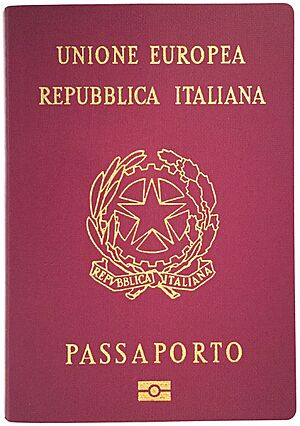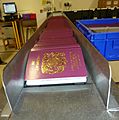Passport facts for kids

A passport is a special travel document. It shows that the person holding it is a citizen of a certain country. Think of it as an official ID that lets you travel outside your home country.
When you have a passport, it's like your country is asking other countries to let you visit. It also makes sure you can come back home easily. Passports are given out by a country's government.
Passports usually show your picture and your signature. They also list your date of birth, your nationality, and where you were born.
What is a Biometric Passport?
Many countries now use passports with special "biometric" features. This means they have a tiny computer chip inside. This chip stores unique information about you, like your fingerprints or a digital image of your face.
This technology helps to confirm that the person using the passport is its true owner. It makes travel safer and helps prevent fake passports.
Countries like Malaysia, Australia, Greece, Israel, New Zealand, Japan, Portugal, Sweden, the United Kingdom, the United States, Germany, Ireland, Poland, Italy, Slovenia, Singapore, Thailand, India, and South Korea use biometric passports. Many more countries are starting to use them too.
When you travel, officials at the border will check your passport. They might stamp it to show you have entered or left their country. This stamp proves your identity was checked.
The History of Passport Languages
A long time ago, in 1920, countries decided on some rules for passports. They agreed that passports should be written in French. They also said it should be in at least one other language.
Today, most countries print passports in English. They also include the main language or languages of the country that issued the passport. This helps people around the world understand them.
Images for kids
-
Passport control at Dubai International Airport
-
An Argentine passport with the name of Mercosur at the top.
-
A Spanish passport as a member of the European Union.
-
A Chinese passport from the Qing Dynasty, 1898.
See also
 In Spanish: Pasaporte para niños
In Spanish: Pasaporte para niños


















